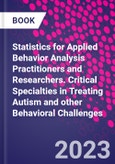Professionals who provide services based on the principles of behavior are required to use evidence-based practices and to make data-based decisions regarding assessments and interventions. Doing so requires statistical literacy: competence in collecting, analyzing, interpreting and presenting aggregate quantitative data within or between subjects. Without statistical literacy, behavior analysts cannot take advantage of, or intelligently discuss, ongoing scientific developments around interventions for autism spectrum disorders (ASD). Statistics for Applied Behavior Analysis Practitioners and Researchers provides practical and useful content for individuals who work directly with, or supervise those who work directly with, individuals with ASD. This book introduces core concepts and principles of modern statistical analysis that behavior analysts will need to deliver and consume the larger scientific literature. The organization of the book follows the common sequence of decisions for collecting, describing and analyzing data associated with behavior analytic service delivery and research. By the end of the book, readers should be able to understand and accurately incorporate statistics in their assessment and intervention effects using statistics.
Please Note: This is an On Demand product, delivery may take up to 11 working days after payment has been received.
Table of Contents
1. The requisite boring stuff Part I: Defining a statistic and the benefit of numbers
2. The requisite boring stuff Part II: Data types and data distributions
3. How can we describe our data with numbers? Central tendency and point estimates
4. Just how stable is responding? Estimating variability
5. Just how good is my intervention? Statistical significance, effect sizes and social significance
6. Oh, shoot! I forgot about that! Estimating the influence of uncontrolled variables
7. How fast can I get to an answer? Sample size, power, and observing behavior
8. Wait, you mean the clock is always ticking? The unique challenges time adds to statistically analyzing time series data
9. This math and time thing is cool! Time series decomposition and forecasting behavior
10. I suppose I should tell someone about the fun I’ve had: Chapter checklists for thinking, writing, and presenting statistics
11. Through the looking glass: Probability theory, frequentist statistics and Bayesian statistics








